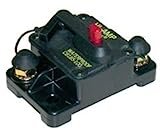Well, it could easily be converted to a turbo oil return if I ever get bored with the SC's torque and decide I want some serious high end HP. ;-)
Yep, that's always been the classic and accepted way of lubing the motor before firing, and frankly, I've never understood or agreed with it. You're still spinning the crank and rods dry in their journals until the lube oil pump starts working. And if the lube oil pump is airlocked (as they are many times), then you really are spinning the motor dry.
With an external prelube system, none of the engine's reciprocating assembly has to turn to generate lube oil flow and pressure.




